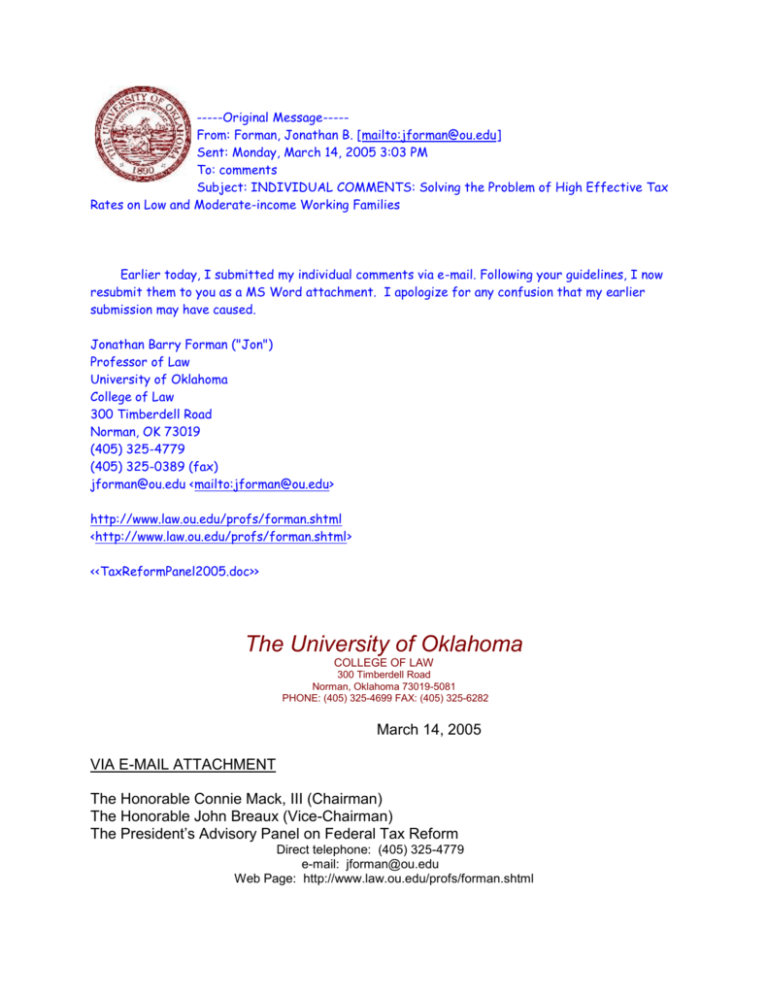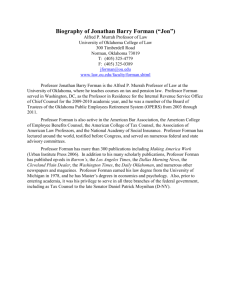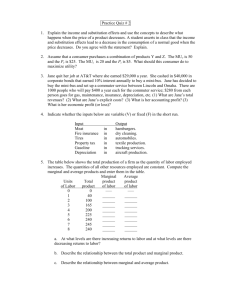031405FormanJonathan
advertisement

-----Original Message----From: Forman, Jonathan B. [mailto:jforman@ou.edu] Sent: Monday, March 14, 2005 3:03 PM To: comments Subject: INDIVIDUAL COMMENTS: Solving the Problem of High Effective Tax Rates on Low and Moderate-income Working Families Earlier today, I submitted my individual comments via e-mail. Following your guidelines, I now resubmit them to you as a MS Word attachment. I apologize for any confusion that my earlier submission may have caused. Jonathan Barry Forman ("Jon") Professor of Law University of Oklahoma College of Law 300 Timberdell Road Norman, OK 73019 (405) 325-4779 (405) 325-0389 (fax) jforman@ou.edu <mailto:jforman@ou.edu> http://www.law.ou.edu/profs/forman.shtml <http://www.law.ou.edu/profs/forman.shtml> <<TaxReformPanel2005.doc>> The University of Oklahoma COLLEGE OF LAW 300 Timberdell Road Norman, Oklahoma 73019-5081 PHONE: (405) 325-4699 FAX: (405) 325-6282 March 14, 2005 VIA E-MAIL ATTACHMENT The Honorable Connie Mack, III (Chairman) The Honorable John Breaux (Vice-Chairman) The President’s Advisory Panel on Federal Tax Reform Direct telephone: (405) 325-4779 e-mail: jforman@ou.edu Web Page: http://www.law.ou.edu/profs/forman.shtml University of Oklahoma Professor Jonathan Barry Forman - 2 1440 New York Avenue, N.W. Suite 2100 Washington, DC 20220 Re: INDIVIDUAL COMMENTS: Solving the Problem of High Effective Tax Rates on Low and Moderate-income Working Families Dear Senators Mack and Breaux: In response to your February 16, 2005, Request for Comments # 1, I am writing to express my concern about the high effective marginal tax rates that are imposed on low and moderate-income working families. I am writing in my individual capacity as a Professor of Law at the University of Oklahoma College of Law where I teach and write about tax and Social Security law. Prior to entering academia, it was my privilege to serve in all three branches of the federal government. The purpose of these comments is to suggest how we could combine the income and Social Security taxes into a comprehensive tax system with low effective marginal tax rates on earned income. Sincerely, Jon Forman Jonathan Barry Forman Professor of Law University of Oklahoma Professor Jonathan Barry Forman - 3 SOLVING THE PROBLEM OF HIGH EFFECTIVE TAX RATES ON LOW AND MODERATE-INCOME WORKING FAMILIES Individual Comments of Jonathan Barry Forman Professor of Law University of Oklahoma College of Law Norman, Oklahoma March 14, 2005 The purpose of these comments is to suggest how we could combine the income and Social Security taxes into a comprehensive tax system with low effective marginal tax rates on earned income. The Current Federal Tax System Imposes High Tax Rates on Earned Income Taxes tend to influence individual choices between labor and leisure, and high effective marginal tax rates on earned income tend to discourage work. The implication is clear. If the government wants to minimize work disincentives, it should keep the effective marginal tax rates on earned income as low as possible. It is especially important to try to have low tax rates on low and moderate-income workers, as they are likely to have the largest behavioral responses to high tax rates. Unfortunately, the current federal tax system imposes its highest effective marginal tax rates on low and moderate-income workers. University of Oklahoma Professor Jonathan Barry Forman - 4 Effective Marginal Tax Rate Charts The federal income tax system has a progressive tax-rate structure; however, because of the many phase-outs and other special rules, effective marginal tax rates can bounce all over the place. And the highest effective marginal tax rates are imposed on moderate-income working families in the phase-out range of the earned income tax credit.1 On the other hand, the Social Security payroll tax is regressive. Workers effectively pay 15.3 percent of their first $90,000 of earned income but just 2.9 percent on earnings in excess of $90,000.2 When both income and payroll taxes are considered, the effective marginal tax rates on earned income can be extraordinarily high, especially on low and moderate-income workers with children.3 For example, Figure 1 shows the effective marginal tax rates imposed on married couples with two children and earned income only in 2005.4 Figure 1 shows that the highest effective 1 The kind of income that a taxpayer receives can also affect her effective marginal tax rate. For example, while earned income is taxed at stated income tax rates as high as 35 percent under the federal income tax, investment income is often taxed at much lower rates. For example, dividends and net capital gains are generally taxed at no more than 15 percent, and the interest earned on state and local bonds is tax-exempt. 2 As is common in this type of analysis, I ignore the value of any future Social Security and Medicare benefits that might result from these payroll taxes. See, for example, Congressional Budget Office, Effective Tax Rates, 1997 to 2000 (2003), 5. Of note, because the half of the payroll tax that is paid by the employer is excluded from the individual’s taxable income, the effective marginal tax rates are actually slightly less than 15.3 and 2.9 percent. 3 Worse still, these high effective marginal tax rates in the federal tax system often combine with similarly high benefit-reduction rates in the welfare system to result in virtually confiscatory effective marginal tax rates on the earned income of many low-income families trying to work their way out of the welfare system. 4 The figure assumes that all family income consists of wages earned by a single University of Oklahoma Professor Jonathan Barry Forman - 5 marginal tax rate – 46 percent – is imposed on couples earning around $30,000 a year. Figure 1 also includes a linear trendline, so that the reader can imagine what a more rational, progressive tax rate structure might look like. FIGURE 1 Combined Effective Marginal Tax Rates (income and payroll taxes), Married Couples with Two Children and Earned Income Only, 2005 Effective tax rate (percentage) 60% 50% 40% 30% Effective Tax Rate Linear Trendline 20% 10% 0% -10% $0 $50,000 $100,000 $150,000 $200,000 $250,000 $300,000 $350,000 -20% -30% Earned income Figure 2 shows similar results for heads of household with two children and earned income only. Figure 2 also shows that the highest effective marginal tax rate – 51 percent – is imposed on heads of household earning around $30,000 a year. worker, that all family members are under age 65 and not blind, that all families are eligible for the earned income tax credit, and that all children qualify for the child tax credit. University of Oklahoma Professor Jonathan Barry Forman - 6 FIGURE 2 Combined Effective Marginal Tax Rates (income and payroll taxes), Single Parents with Two Children and Earned Income Only, 2005 Effective tax rate (percentage) 60% 50% 40% 30% Effective Tax Rate Linear Trendline 20% 10% 0% -10% $0 $50,000 $100,000 $150,000 $200,000 $250,000 $300,000 $350,000 -20% -30% Earned income Integrate the Income and Payroll Taxes Many of the problems of the current tax system would disappear if we combined the income and payroll taxes into a single, comprehensive income tax system. For example, consider an integrated income/payroll tax system with $1,000 per person refundable tax credits and just two tax rates: 20 percent of the first $50,000 of income and 30 percent on income in excess of $50,000. To encourage work, the system could also have a $2,000 per worker refundable earned income tax credit (computed as 20 percent of the first $10,000 of earned income). There would be no need to phase out either the refundable personal tax credits or the worker credits. Figure 3 shows how this system would work. University of Oklahoma Professor Jonathan Barry Forman - 7 FIGURE 3 Effective Marginal Tax Rates for a Married Couple with Two Children in an Integrated Income/Payroll Tax System (with 20 and 30 Percent Tax Rates, $1,000 Refundable Personal Tax Credits, and $2,000 Per Worker Earned Income Tax Credits) Marginal tax rate (percentage) 60% 50% 40% Effective Tax Rate Linear Trendline 30% 20% 10% 0% $0 $50,000 $100,000 $150,000 $200,000 $250,000 $300,000 $350,000 Earned income All in all, such an integrated tax system would have a logical tax rate structure, as opposed to the roller-coaster rate structure of the current tax system. An integrated system would be simpler to administer than the current system, it would promote greater economic justice than the current system, and it would minimize work disincentives,. Low and moderate-income families would have every incentive to get out there and work, and even high-income families would face smaller work disincentives than under the current system. In short, this approach would help make our tax system work. Respectfully submitted, Jon Forman Jonathan Barry Forman Professor of Law University of Oklahoma Professor Jonathan Barry Forman - 8 University of Oklahoma College of Law Norman, Oklahoma








